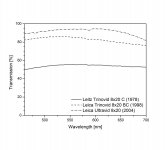Hi JC,
The short answer is: 'No one outside of Zeiss knows' and the same is the case with the other optics manufacturers.
There are various manufacturers of optical glass, with three of the major producers of high quality glass being Schott, Hoya and Hikari/ Nikon.
See a link for each in post #12 at:
Glass types in NL Pure-series
And while each has a comprehensive catalogue of optical glass, it's only a small part of their overall production.
Binocular manufacturers use a variety of glass in each model, depending on the optical needs/ performance balance that they’ve chosen
(including the price point).
The optical designs of the Zeiss Pocket x25 and the the SF x42 are fundamentally different (the number of lenses and groupings), and so the glass used for the individual lenses will differ. Likewise the optical designs of SF x32 and x42 are also significantly different, so again the glass used will differ.
- - - -
One of the things that needs to be considered is the difference between objective transmission and subjective/ perceived brightness.
As an example, I have a Leica UV 8x20 along with a UV HD 8x42. From the comprehensive work of Gijs van Ginkel (at:
Verrekijker testen | House Of Outdoor & Optics ), we know that the 8x20 has significantly higher transmission than the 8x42. See a graph of the 8x20 UV from a 2020 test, and a graph comparing the 8x42 UV HD and UV HD+ from a 2016 test.
However, even in bright conditions (where the 8x20’s smaller exit pupil is not an issue), the image from the larger model is perceptibly brighter.
John






